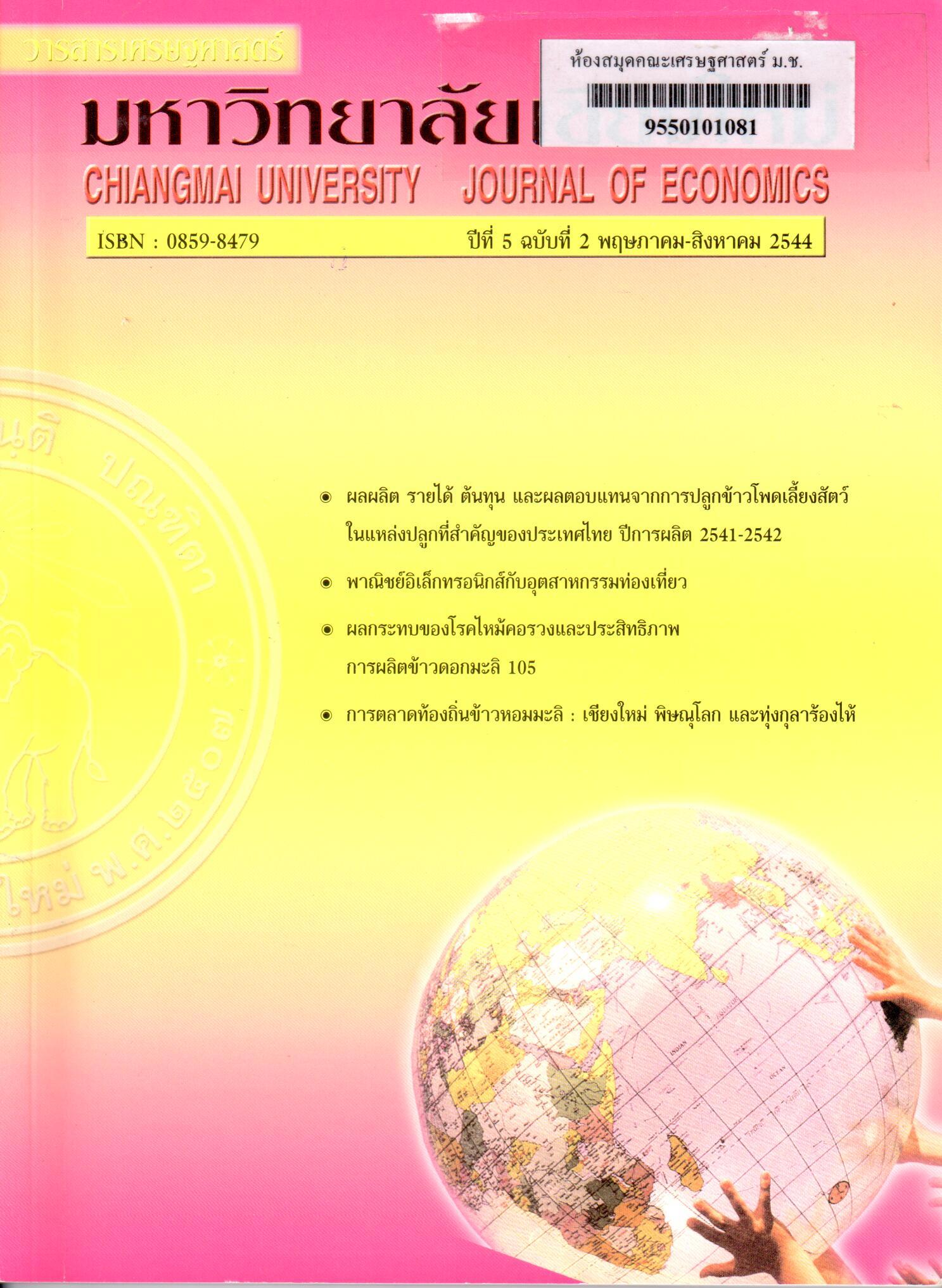ผลผลิต รายได้ ต้นทุน และผลตอบแทนจากการปลูกข้าวโพดเลี้ยงสัตว์ในแหลางปลูกที่สำคัญของประเทศไทย ปีการผลิต 2541-2542
Abstract
บทคัดย่อ
วัตถุประสงค์ของการศึกษานี้ เพื่อศึกษาสภาพการผลิต หาระดับผลผลิต ต้นทุนการผลิต รายได้และผลตอบแทนจากการผลิตข้าวโพดเลี้ยงสัตว์ในแหล่งผลิตสำคัญของประเทศไทย โดยการสัมภาษณ์เกษตรกรในพื้นที่ภาคเหนือ ภาคตะวันออกเฉียงเหนือ และภาคกลาง จำนวน 6 จังหวัด 11 อำเภอ 21 ตำบล รวม 218 ครัวเรือน ครอบคลุมการผลิตทั้งเกษตรกรที่ปลูกข้าวโพดในช่วงต้นฤดูฝน ปลายฤดูฝน และฤดูแล้งหลังนา ปีการผลิต 2541-2542
ผลการศึกษาพบว่า ร้อยละ 98 ของเกษตรกรตัวอย่างปลูกข้าวโพดพันธุ์ลูกผสม โดยในปีการผลิต 2541 เกษตรกรที่ปลูกข้าวโพดต้นฤดูฝนได้ผลผลิตเฉลี่ย 591 กิโลกรัม/ไร่ ต่ำกว่าเกษตรกรที่ปลูกข้าวโพดในช่วงปลายฤดูฝนที่ได้ผลผลิตเท่ากับ 624 กิโลกรัม/ไร่ เช่นเดียวกับการผลิตในปี 2542 ที่เกษตรกรที่ปลูกข้าวโพดต้นฤดูฝนได้ผลผลิตเฉลี่ย 510 กิโลกรัมต่อไร่ ต่ำกว่าเกษตรกรที่ปลูกข้าวโพดในช่วงปลายฤดูฝนและฤดูแล้งหลังนาที่ได้ผลผลิตเท่ากับ 558 กิโลกรัมต่อไร่ และ 796 กิโลกรัมต่อไร่ ตามลำดับ ขณะที่ราคาจำหน่ายผลผลิตเฉลี่ย อยู่ที่ 3.4 - 4.0 บาท/กิโลกรัม สำหรับต้นทุนการผลิตข้าวโพดทั้งหมดในฤดูต้นฝน และฤดูปลายฝน ในปีการผลิต 2541 – 2542 อยู่ระหว่าง 1,500 – 1,700 บาท/ไร่ ส่วนการผลิตในฤดูแล้งหลังนา ปี 2542 ต้นทุนการผลิต เท่ากับ 2,137 บาท/ไร่ เมื่อหักรายได้ด้วยต้นทุนการผลิต พบว่าเกษตรกรที่ปลูกข้าวโพดปลายฤดูฝนได้รับกำไรสุทธิและรายได้สุทธิเหนือต้นทุนที่เป็นตัวเงินสูงกว่าเกษตรกรที่ปลูกข้าวโพดต้นฤดูฝนทั้งสองปี โดยเกษตรกรที่ปลูกข้าวโพดปลายฤดูฝนได้รับกำไรสุทธิ 873 บาท/ไร่ และ 629 บาท/ไร่ในปี 2541 และ 2542 ตามลำดับ ขณะที่ผู้ปลูกต้นฤดูฝน ได้กำไรสุทธิเท่ากับ 398 บาท/ไร่ และ 350 บาท/ไร่ ในปีการผลิต 2541 และ 2542 ตามลำดับ สำหรับการปลูกข้าวโพดในฤดูแล้งในพื้นที่นาได้กำไรสุทธิเท่ากับ 569 บาท/ไร่ ต่ำกว่าการปลูกช่วงปลายฤดูฝน แต่สูงกว่าการปลูกในช่วงต้นฤดูฝน แต่มีผลตอบแทนสุทธิเหนือต้นทุนที่เป็นตัวเงินสูงที่สุด คือเท่ากับ 1,560 บาท/ไร่ และเมื่อดูตามขนาดฟาร์ม เฉพาะการผลิตในช่วงต้นฤดูฝน ปี 2541 พบว่าฟาร์มขนาดเล็กที่มีพื้นที่ปลูกข้าวโพดน้อยกว่า 20 ไร่ ได้กำไรสุทธิและผลตอบแทนสุทธิเหนือต้นทุนที่เป็นตัวเงินสูงที่สุด เท่ากับ 600 บาท/ไร่ และ 999 บาท/ไร่ ตามลำดับ โดยที่ฟาร์มขนาดกลางที่มีพื้นที่ปลูก 20 – 40 ไร่ และฟาร์มขนาดใหญ่ที่มีพื้นที่ปลูกมากกว่า 40 ไร่ มีกำไรสุทธิ 508 บาท/ไร่ และ 180 บาท/ไร่ และมีผลตอบแทนสุทธิเหนือต้นทุนที่เป็นตัวเงิน 845 บาท/ไร่ และ 386 บาท/ไร่ ตามลำดับ
จากผลการศึกษาที่ได้ ชี้ให้เห็นว่าการผลิตข้าวโพดปลายฤดูฝน ฤดูแล้งในพื้นที่นา และในฟาร์มขนาดเล็ก ให้ผลตอบแทนเฉลี่ยต่อไร่ดีกว่า อย่างไรก็ตามถ้าดูผลตอบแทนต่อครัวเรือน ฟาร์มขนาดใหญ่ย่อมได้รับผลตอบแทนมากกว่า คือเฉลี่ยประมาณ 35,000 บาท/ครัวเรือน และเมื่อดูลึกลงไปในแต่ละตำบลพบว่ามีหลายพื้นที่เกษตรกรมีต้นทุนการผลิตสูงในขณะที่ผลผลิตที่ได้ค่อนข้างต่ำ ทำให้ขาดทุนสุทธิ หรือได้กำไรจากการผลิตน้อย ซึ่งควรต้องมีการแนะนำส่งเสริมเป็นพิเศษเพื่อยกระดับการผลิตในพื้นที่เหล่านี้
Abstract
The objective of this study is to assess production practices, output, costs of production, income and return from maize production in major maize growing area of Thailand. Total 218 farm households in 6 provinces 11 districts and 21 subdistricts were interviewed, covering production in the early rainy, late rainy and dry season after paddy rice in production year 1998-1999. The results showed that among 218farmers, 98 per cent of the farmers used hybrid maize varieties. The average yield of maize production in early rainy season in 1998 were 591 kg per rai, lower than the average yield of late rainy season were 624 kg per rai. Similarly, the average yield of maize production in early rainy season in 1999 were 510 kg per rai, compared to 558 and 796 kg per rai of late rainy and dry season respectively. Average farm gate price ranged between 3.4 and 4.0 bath per kg. In addition, it was found that the average costs of maize production in early and late rainy season in production year 1998-1999 were about 1,500 to 1,700 bath per rai. The average costs of maize production in dry season in production year 1999 were 2,137 bath per rai. Net returns of maize production in late rainy season were 873 and 629 bath per rai in production year 1998 and 1999, respectively. While net return of maize production in early rainy season were 398 and 350 bath per rai in production year 1998 and 1999, respectively. Net return of maize production in dry season were 569 bath per rai lower than in the late rainy season in the same year. However, it was found that gross margin of maize production in dry season was the highest about 1,560 bath per rai. With respect to farm size of maize production in early rainy season in production year 1998, it was found that small maize farmers who grown maize less than 20 rai obtained gross margin and net return about 600 and 999 per rai, respectively. Medium farm size with 20-40 rai and large farm size with more than 40 rai obtained net return about 508 and 180 bath per rai, and gross margin about 845 and 386 bath per rai respectively.
The result showed that maize production in late rainy season, dry season and small farm size were more profitable on a per rai basis, Nevertheless, income wise, large famers yields had more income per farm with an average 35,000 bath per household. Generally for many subdistricts, it was found that farmers had high costs of production while yields were low resulting in loss or meager profit. There should be special extension programs to improve yields in these areas.
Downloads
Issue
Section
License
All opinions and contents in the CMJE are the responsibility of the author(s). Chiang Mai University Journal of Economics reserves the copyright for all published materials. Papers may not be reproduced in any form without the written permission from Chiang Mai University Journal of Economics.
ข้อคิดเห็นที่ปรากฏและแสดงในเนื้อหาบทความต่างๆในวารสารเศรษฐศาสตร์มหาวิทยาลัยเชียงใหม่ ถือเป็นความเห็นและความรับผิดชอบโดยตรงของผู้เขียนบทความนั้นๆ มิใช่เป็นความเห็นและความรับผิดชอบใดๆของวารสารเศรษฐศาสตร์ มหาวิทยาลัยเชียงใหม่
บทความ เนื้อหา และข้อมูล ฯลฯ ในวารสารเศรษฐศาสตร์มหาวิทยาลัยเชียงใหม่ ถือเป็นลิขสิทธิ์เฉพาะของคณะเศรษฐศาสตร์มหาวิทยาลัยเชียงใหม่ หากบุคคลหรือหน่วยงานใดต้องการนำทั้งหมดหรือส่วนหนึ่งส่วนใดไปเผยแพร่ต่อหรือเพื่อกระทำการใดๆ จะต้องได้รับอนุญาตเป็นลายลักษณ์อักษร จากวารสารเศรษฐศาสตร์ มหาวิทยาลัยเชียงใหม่






